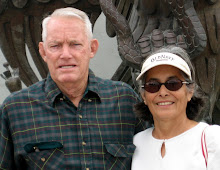 Waiting on a Ranger so we can register. Stay tuned for Sedona...........
Waiting on a Ranger so we can register. Stay tuned for Sedona........... Ah-h, here it is.
Ah-h, here it is. Somewhere around here should be our next park.
Somewhere around here should be our next park.








 And away we go again, headed to Cottonwood Arizona.
And away we go again, headed to Cottonwood Arizona. I took this picture off of Interstate 40. This is where we were parked, right of the interstate.
I took this picture off of Interstate 40. This is where we were parked, right of the interstate.


 The railroad linked Williams with far-away markets. In 1893, the Saginaw Lumber Company opened a large mill and later a box factory. The business was a major factor in the town's economy until its closure in 1940.
The railroad linked Williams with far-away markets. In 1893, the Saginaw Lumber Company opened a large mill and later a box factory. The business was a major factor in the town's economy until its closure in 1940. You can get your tickets for train rides to the Grand Canyon. There is also a gift shop here.
You can get your tickets for train rides to the Grand Canyon. There is also a gift shop here. This is the entrance to their Railroad Depot.
This is the entrance to their Railroad Depot.Williams had a reputation as a rough, tough and rowdy frontier town by the turn of the century. Its saloons, brothels, opium dens and gambling houses catered to the cowboy, logger, Chinese laborer and railroad worker. These businesses were restricted by ordinance to Railroad Avenue's "Saloon Row." Legitimate business flourished along Bill Williams Ave but the towns principal merchant, Cormick E. Boyce, is attributed with the building of the town. Most of the wooden buildings from the early period burned down in a series of disastrous fires.








 In 1821 Mexico gained independence from Spain, thereby opening the Arizona territory to trappers and mountain men. Williams was named after one of these fabled mountain men, William Williams. The surrounding valleys and meadows drew ranchers and farmers after the Civil War. In 1879, Cattleman Charles T. Rodgers purchased land at the foot of Bill Williams Mountain in anticipation of construction of the transcontinental railroad. Following the arrival of the (Atlantic & Pacific RR) in 1882, Williams quickly grew as a center for the railroad, ranching and lumber industries.
In 1821 Mexico gained independence from Spain, thereby opening the Arizona territory to trappers and mountain men. Williams was named after one of these fabled mountain men, William Williams. The surrounding valleys and meadows drew ranchers and farmers after the Civil War. In 1879, Cattleman Charles T. Rodgers purchased land at the foot of Bill Williams Mountain in anticipation of construction of the transcontinental railroad. Following the arrival of the (Atlantic & Pacific RR) in 1882, Williams quickly grew as a center for the railroad, ranching and lumber industries. 
 This is the statue of Williams. William Sherley Williams was born in 1787 in North Carolina. He was killed by the indians in 1849. He had a town, a mountain and a river named after him.
This is the statue of Williams. William Sherley Williams was born in 1787 in North Carolina. He was killed by the indians in 1849. He had a town, a mountain and a river named after him. This is a triangle little park that has a statue of William Williams among other things.
This is a triangle little park that has a statue of William Williams among other things. In 1926, US Highway 66 was established through Williams, which served the touring public as part of "Main Street of America." Williams became the last "Route 66" town in America to be bypassed in 1984. Bill Williams Avenue, a section of America's Main Street, won national Historic Register status in 1989.
In 1926, US Highway 66 was established through Williams, which served the touring public as part of "Main Street of America." Williams became the last "Route 66" town in America to be bypassed in 1984. Bill Williams Avenue, a section of America's Main Street, won national Historic Register status in 1989. In 1901, a spur line was built to the Grand Canyon. Williams became known as the "GATEWAY TO THE GRAND CANYON." Travelers found luxurious accommodations at the Fray Marcos, one of the many "Harvey Houses built by the Santa Fe Railroad and operated in partnership with Fred Harvey Company. Thousands of well-bred young women were recruited from the eastern United States to work in the restaurants and hotels. "Harvey Girls" were renowned for their charm and gracious service.
In 1901, a spur line was built to the Grand Canyon. Williams became known as the "GATEWAY TO THE GRAND CANYON." Travelers found luxurious accommodations at the Fray Marcos, one of the many "Harvey Houses built by the Santa Fe Railroad and operated in partnership with Fred Harvey Company. Thousands of well-bred young women were recruited from the eastern United States to work in the restaurants and hotels. "Harvey Girls" were renowned for their charm and gracious service.







No comments:
Post a Comment